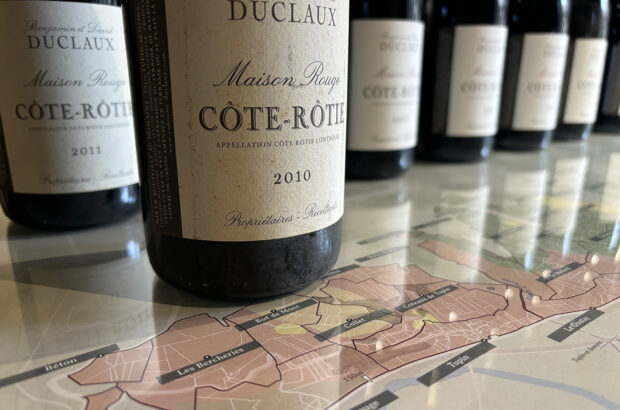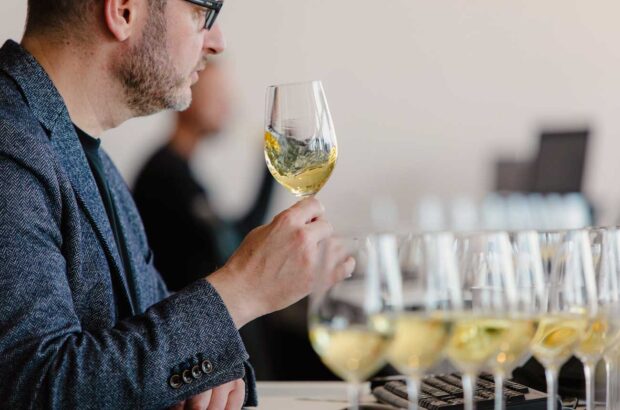Behind the walls: It is one of Burgundy’s most famous – and complex – sites, with 80 growers sharing 50ha of this walled vineyard, producing wines of vastly different quality. Christelle Guibert tastes the now-bottled 2008s
THE MONKS HAD it right. Back in 1098, the Cistercian brotherhood of Cîteaux established an abbey in Vougeot,
between Vosne-Romanée to the south and Chambolle- Musigny to the north. When they then acquired donations in the form of land, they swiftly turned it into vineyards. By 1160, a press house and cellar had been built. The vineyard continued to grow, with the last land donation coming in 1336. A century later, the wall forming the Clos was completed (a clos is a wall-enclosed vineyard).
Clos de Vougeot – also called Clos Vougeot – remained in the ownership of the abbey until the French Revolution in 1789, when it was requisitioned by the state and sold off. The Clos changed hands several times – always as a single property – but in 1889 it was subdivided, when bought by six Burgundian merchants. Inheritance laws and land sales have since seen the vineyards further subdivided, and today more than 80 owners share the 50.6 hectare site: an average of 0.63ha (3,000 bottles) per grower.
Even by the start of the 20th century, the price of Clos de Vougeot land was no higher than that of village-level
wines in Aloxe-Corton or Fleurie, in Beaujolais. Today, though, Clos de Vougeot is one of Burgundy’s most
sought-after vineyards.
Clos de Vougeot is the smallest commune but the largest grand cru in the Côte d’Or, so not surprisingly, it plays host to several different soil types. Add in the individual signatures of the 80 owners and you can imagine the variation in the wines. Unlike the rest of Burgundy, the entire Clos has been classified as grand cru, regardless of the differing soil types and terroirs. The top of the Clos (bordering the grand cru Grand-Echézeaux) is the best land – pebbly, oolitic limestone. The exceptional terroir was identified by the monks, who used it for their top wine: the Cuvée du Papes. Halfway down the slope, the soil is a mix of limestone and clay; the monks used this for their mid-level Cuvée du Roi. Further down still, the soil becomes more alluvial and drains less well – the plots left for the monks’ basic Cuvée des Moines.
A mixed bag
Producer is key in Burgundy. While Clos de Vougeot ranks among the top grands crus, according to Simon Davies of Fine & Rare, ‘a bottle from a decent grower can be a terrific bargain’. But Jasper Morris MW of Berry Bros & Rudd says they’re not his favourite: ‘All the négociants carry a [Clos Vougeot] wine, so there is a slight glut in the market. But the Clos’ history and pageantry certainly help to underpin sales.’ Michael Schuster, the Decanter World Wine Awards Regional Chair for Burgundy, feels Clos de Vougeot ‘epitomises the frustrating chaos’ that is fine Burgundy. ‘It is one name but there are many dozen wines, with few that are fine representatives of grand cru quality.’ With 35 years of considered Burgundy consumption, Schuster says he ‘cannot bring to mind one bottle of Clos de Vougeot that stands out’ in his memory.
A horizontal tasting of 57 wines from the same grand cru is an unique experience, and a great opportunity to put these opinions to the test, and understand the various terroirs within the Clos. This tasting of Clos de Vougeot
was organised by London broker Fine & Rare Wines, which convinced 70% of growers in the Clos to take part.
When released, the 2008 received mixed reviews, but two years on, and now in bottle, the wines show nice purity,
balance, freshness and finesse – a classic Burgundian style. 2008 is a vintage that lays bare the terroir and abilities
of the winemakers. I thought that if I was going to try to understand Clos de Vougeot and its growers, then 2008
was the vintage to do it,’ concluded Davies.
Written by Christelle Guibert






